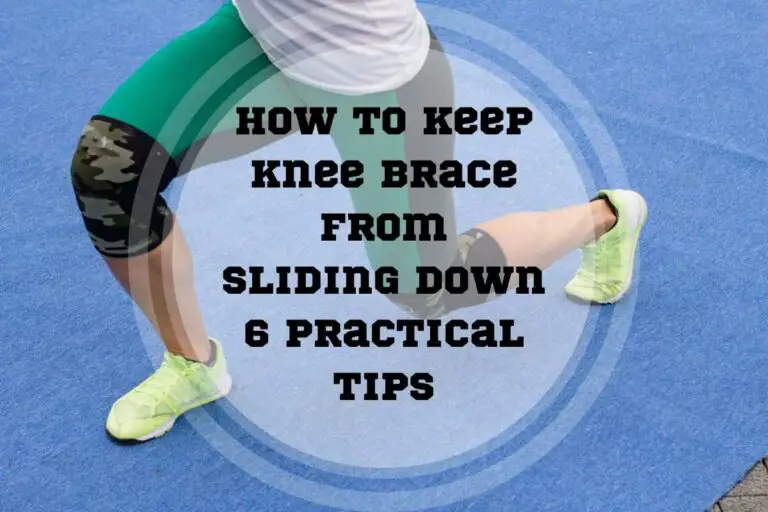Groin Pain in Runners: 5 Causes, 5 Symptoms + 3 Treatments
Reviewed by: Ernesto Mendez (Orthopedic Clinical Specialist)
Groin pain in runners is not a common ailment, but it can happen. If you’re trying to get back into shape for running and want to understand why your groin hurts during longer runs, this article provides an outline of what groin pain may mean and solutions for managing it.
Let’s find out the real cause of your discomfort once and for all!
What is the cause of discomfort in groin pain?
Common signs of groin pain in runners include tenderness, swelling, and bruised muscles that lead to difficulties walking or running. It is important to seek professional advice immediately when experiencing severe groin pain and to rest when necessary while gradually building up strength using targeted exercises.
What Is Groin Pain in Runners?
Groin pain in runners, or “pulled groin,” is an overuse injury that occurs due to repetitive stress on the muscles and tendons located near the inner thigh. It is often caused by sudden movements, like rapid changes of direction while running, which puts additional strain on the adductor muscles and other areas within the groin area.
Anatomically speaking, both men and women’s groin areas consist of a complex system of several muscles that are vulnerable when pushed too far during intense training sessions.
Pain with groin injuries can range anywhere from mild discomfort to debilitating soreness after exercise, limiting the ability to perform certain movements if not treated effectively. Female groin pain after running may cause more discomfort than with men because their hip structure gives them less stability.

5 Reasons When Groin Pain Can Result from Running
Runners may experience groin pain due to several reasons. Let’s take a closer look at them.
1. Pulled Groin
A pulled groin is a common cause of groin pain among runners. It occurs when the muscles and tendons in the inner thigh are torn or stretched beyond their normal range due to certain running activities, such as quick turns and hill intervals.
Symptoms can include pain in the groin area, which may be tender to touch, as well as swelling and bruising of the affected area. Muscle spasms, weakness in one of your legs, and trouble walking or running may also occur.
2. Adductor/Inguinal Tendinopathy
Adductor tendinopathy is a common cause of groin pain in runners, characterized by chronic pain around the adductor muscles and their connections close to the pubic bone. Pain in this area can occur during palpation or adduction of the legs.
This differs from a typical groin strain from running because it is usually caused by an acute injury with more immediate symptoms, like swelling, tenderness, and weakness.
3. Hip Joint Impingement
Hip impingement is a condition in which the ball of the hip joint pinches up against the cup, leading to damage and pain. It is sometimes referred to as femoroacetabular impingement and can present with symptoms such as stiffness in the hips, gait disturbances, difficulty standing from sitting positions, and pain in the groin area.
In athletes, hip impingement often manifests as localized anterior or posterior hip and/or groin pain that worsens during activities that involve larger ranges of motion, creating compression between pelvic bones through adduction movements. Pain may also be present while running on an incline or uneven terrain because of increased loading at the ranges where pinching occurs.
4. Osteitis Pubis
Osteitis pubis is a type of bone inflammation caused by repeated minor trauma, typically found in soccer players, runners, and rugby players. Symptoms include severe groin and pelvic pain, which can make it difficult to perform everyday activities, including running.
5. Gilmore’s Groin
Gilmore’s groin, also known as a sportsman’s hernia, is a common cause of sore groin after running that often goes undiagnosed. It is characterized by a strain in the muscles or tendons of the inner thigh near the groin area and commonly occurs from repetitive accelerations, decelerations, kicking, and changing of direction.
Symptoms can range from deep pain that may develop suddenly or gradually over time to swelling, bruising, muscle spasms, and difficulty walking and running.
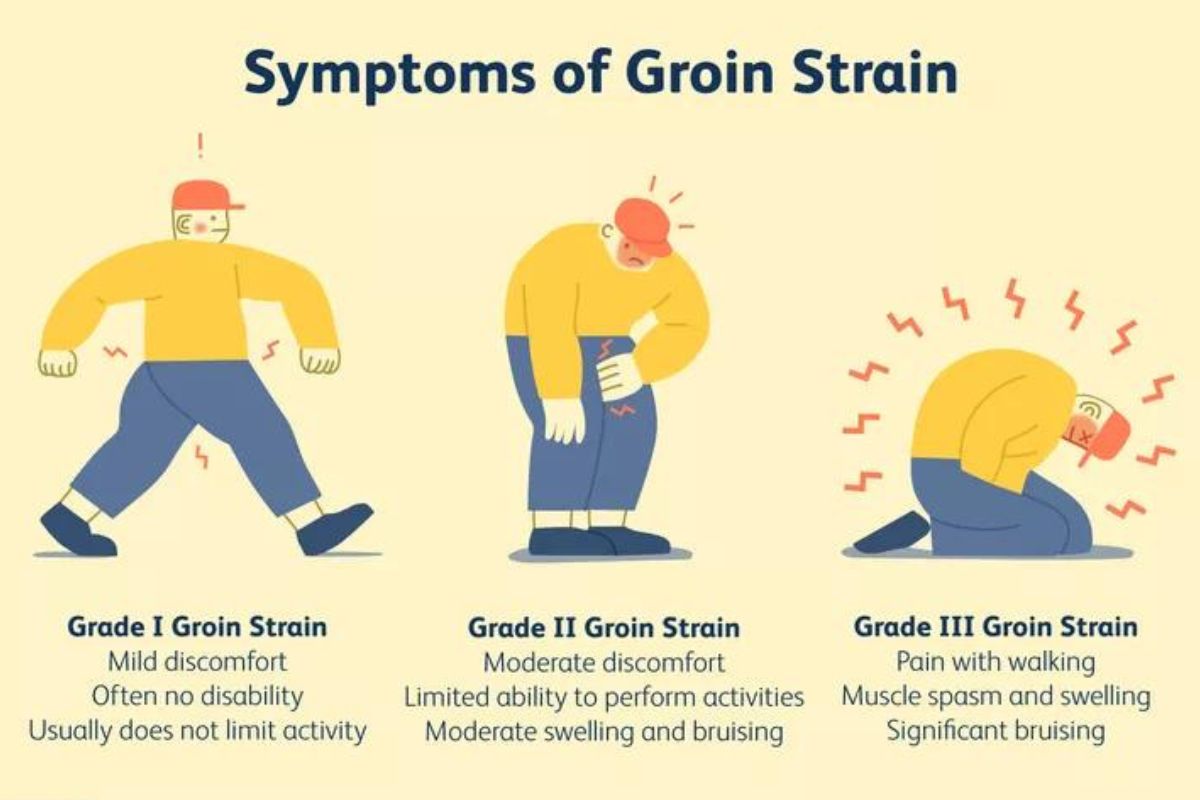
5 Main Symptoms of a Groin Strain
Let’s discuss the main symptoms that indicate groin pain from running.
1. Pain and Tenderness in the Groin Area
Athletes sometimes experience pain and tenderness in the groin area. This soreness can be caused by muscle or tendon strains that are typically associated with activities like hockey, soccer, and football.
However, runners may suffer from similar injuries due to the high impact of running on the muscles around the groin area. When this type of injury occurs, pain will usually be experienced where the abdomen ends and the legs begin. It might worsen when walking or attempting certain physical activities shortly after running.
2. Swelling and Bruising
Swelling and bruising are common symptoms of muscle, tendon, or ligament strain in athletes such as runners. These injuries occur when muscles and tendons become overworked, resulting in tears that can lead to immediate pain and swelling.
Bruising often follows the swelling when tiny blood vessels are damaged within these strained tissues, causing skin color change.
3. Muscle Spasms
Muscle spasms are a common symptom of pulled groin from running. They can cause intense and sudden discomfort, which may last for several seconds or minutes. Muscle spasms in the groin area are typically caused by overstretching, compression of nerves, inflammation from tendonitis, tears in surrounding ligaments or muscles, and poor posture during running.
4. Weakness in the Leg
When a runner sustains a groin strain, they can experience weakness in the leg. This may manifest as a lack of strength when pushing off the ground, walking, or running. Weakness is indicative of muscle involvement and likely shows there has been inflammation to a certain group (e.g., adductor muscles).
5. Trouble Walking or Running
Runners who experience groin pain may find it difficult to carry out even the most basic physical activities, such as walking or running. This type of injury affects up to 5% of muscle fibers and causes discomfort during movement, particularly when running, jumping or stretching. Pain experienced in these activities can indicate a more serious problem that should be addressed by a medical professional.
4 Ways to Treat Groin Pain when Running
You can practice self-care to relieve groin pain after running. However, you should consult a medical professional if the pain persists. Here are some tips to ease your pain.
1. Rest and Relative Rest
Resting and protecting the injured or sore groin area are essential for helping manage groin pain in runners. Generally, a rest of 1 to 2 weeks is recommended. During this time, avoid activities that further aggravate the injury.
Instead, opt for gentler activities, such as walking at an even pace without any incline or decline, which could put additional strain on the affected muscle group. Relative rest also gives muscles ample time to recover from exercise-induced inflammation and tension, while still participating in some form of light physical activity. For instance, replacing a run with swimming laps or using an elliptical trainer may be helpful.
2. Strengthening and Mobility Exercises
Recovery exercises are essential for athletes who experience groin soreness after running, as they can help to both prevent and treat the condition. These exercises target the inner thigh area to build strength and improve flexibility in order to reduce groin strain.
Specific strengthening exercises that can be beneficial for runners include hip adductor stretches, hamstring stretches, straight leg raises, resisted hip flexion exercises, isometric ball squeeze, and adductor drag.
3. Gradual Return to Running
A slow and gradual return to groin injury running after experiencing groin pain is essential for a full recovery. To avoid re-injury, it’s important to increase distance and intensity gradually over time, with careful monitoring.
Recovery should start with rest, then add low-intensity exercises such as walking and stretching before progressing into light jogging at an easy pace. Gradually increasing both mileage and speed can help runners find an optimal, balanced training program that prevents future injuries while maximizing performance benefits.
4. Importance of Warm-Up
A proper warm-up routine before running is essential for preventing groin pain and other injuries, especially among runners. Warm-ups should include dynamic stretching exercises that target the entire body, including the muscles around the hips and groin.
This helps increase blood flow to these areas, preparing them for exercise. It also increases flexibility by helping maintain movement in all directions while running.
6 Tips How to Run with a Groin Strain
With proper treatment and rehabilitation, it is possible to run after a groin strain, although you should expect the healing process to take several weeks or months. Here are some useful tips.
1. Take Rest When Necessary
When experiencing groin pain from running, it is essential to rest and protect the injured or sore area for 1-2 weeks in order to allow sufficient time for recovery. Complete bed rest may not always be required, but activities that cause additional discomfort should be stopped, changed, or taken a break from until pain subsides and no longer limits performance.
Recovery time varies depending on the severity of the injury, but may take 4-6 weeks to fully heal. If there are concerns regarding how quickly you are recovering, seek professional medical advice, as severe grade 3 strains can take over 4 months to completely heal.
2. Gradually Build Strength and Flexibility
Gradually building strength and flexibility in the groin area is essential for runners to prevent and manage groin pain and injuries. Poor flexibility or tight hip flexors can place excessive stress on the muscles of the thigh, leading to a pulled groin muscle or other related injury.
Additionally, you should focus on strengthening these muscles by adding exercises like lateral band walking, reverse clamshells, or squats with paused halfway positions, which are all effective ways of targeting both single legs while engaging various hip stabilizers simultaneously.
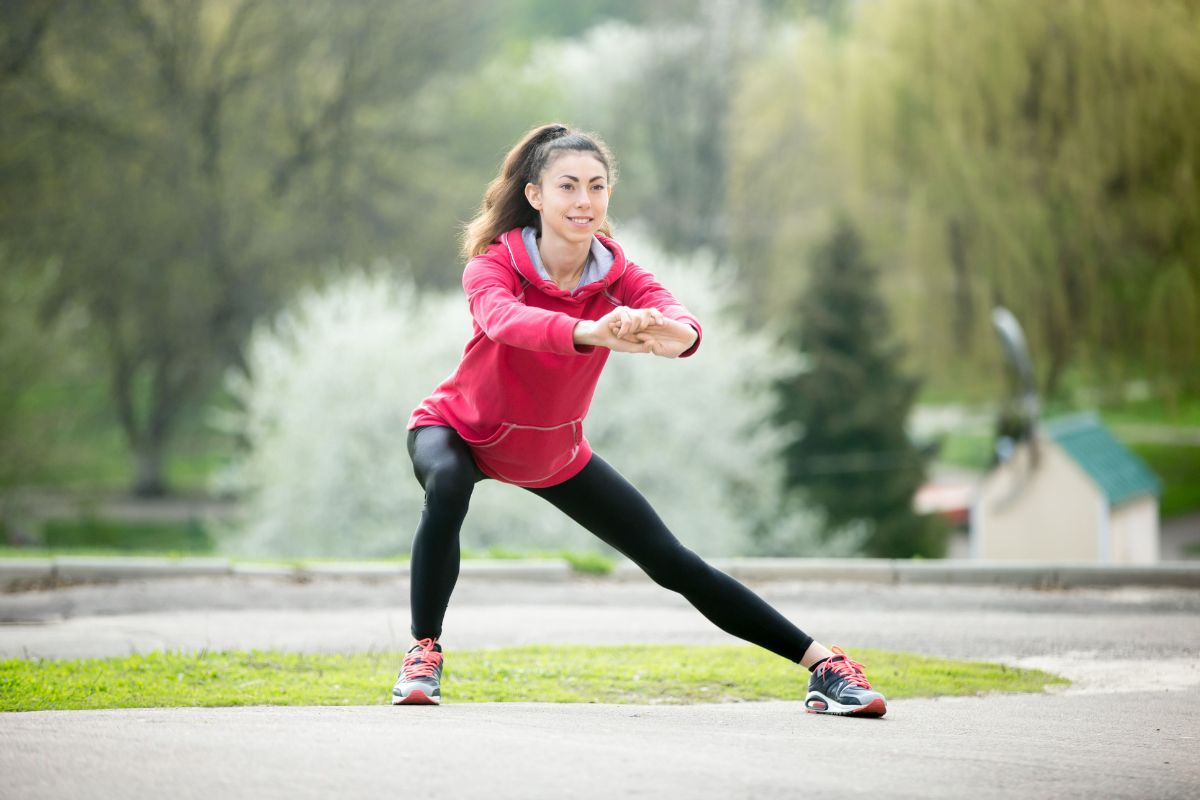
3. Use Proper Stretching Techniques
Stretching is a key part of any running routine and should not be overlooked. By regularly stretching, runners can improve their hip joint range of motion and reduce the risk of sustaining a groin injury.
4. Use Ice Therapy for Pain Relief
Ice therapy can be used to help relieve pain in the groin area caused by running. Ice packs reduce swelling and inflammation, numbing the affected area for up to 2 hours. It is recommended that athletes with pain in the inner thigh near the groin after running use ice therapy every 3 to 4 hours for 2 to 3 days, or until the pain subsides.
Pro Tip:
To avoid skin damage, make sure you wrap your ice pack in a thin cloth before using it on your body. When applying cold treatment, give yourself 10-15 minutes of rest before reapplying. This will provide relief and prevent tissue damage at the same time.
5. Consider Modifying Your Running Technique
Modifying your running technique is an important component of preventing and managing groin pain in runners. Pronation, foot strike, stride length, and posture are all factors that can influence the amount of stress placed on the primary groin muscles.
For example, running with a heel-striking stride pattern rather than a midfoot/forefoot-striking pattern increases pressure on the inner thigh muscle fibers. Similarly, overstriding can increase pressure across the pubic bone, leading to injury, particularly in longer distance runners who land heavily with each step.
6. Consult a Professional If Pain Persists
If the pain and discomfort from groin strain don’t improve with rest and home remedies, or worsen after running or resuming activity, it is important to seek professional help.
Consulting a sports medicine doctor or physical therapist can help you properly diagnose the injury and provide appropriate treatment plans. Professional help may involve exercises for flexibility training and strength building that are specific to an individual’s needs.
Subscribe to Our Running Newsletter!
Get free running tips from renowned professional athletes and discounts from top-notch brands.
5 Recommendations for the Prevention of Sprains and Groin Pain for Runners
Here are some preventive steps you can take.
1. Warm Up Before Running
Warming up before a run is essential for preventing muscle strain and injuries. It helps to prepare both physically and psychologically for the upcoming challenge, increasing circulation, raising heart rate and body temperature, and loosening tight muscles that often develop from sitting or inactivity.
2. Stretch and Strengthen Regularly
Regular stretching and strengthening exercises are essential for athletes, especially runners, to reduce groin pain. Stretching helps ease the tight muscles that can be a primary cause of injury and discomfort, and also speeds up repair when coming back from a strain.
Strengthening should initially be done with higher reps at lower weights to build strength gradually in all muscle groups related to running. Physical therapists can guide you through these exercises properly, since they have extensive experience managing injuries such as groin tears and strains.
3. Listen to Your Body and Rest When Needed
Running is a demanding activity that can take a toll on the body. Groin pain in runners is very common and can occur due to muscle strain or other underlying conditions. To manage this, it’s important to listen to your body for signs of pain, soreness, tightness, or discomfort while running, and to rest when needed.
Ignoring such signs may result in an acute injury like a sprain or muscle tears. Disregarding persistent pain can lead to chronic injuries like shin splints or stress fractures—all of which require longer recovery times compared to resting adequately as soon as the initial symptoms are noticed.
4. Gradually Increase Intensity and Mileage
It is essential for runners to take their time with increased levels of training, as this will enable them to properly adjust and condition their bodies while still allowing sufficient rest time after each workout session.
Having a plan set up for gradually increasing intensity and mileage can help ensure that runners don’t overwhelm themselves by pushing beyond what they are capable of at any given point in time.
5. Wear Appropriate Footwear
Wearing shoes that are well suited to running can play an important role in avoiding injury and preventing groin pain. Properly fitting, quality footwear is essential because it provides cushioning and support that reduces the stress on the feet, ankles, legs, and lower back.
5 Useful Trainings to Avoid Groin Sprains and Pain for Runners
Incorporating a few targeted exercises into your routine can help to strengthen the muscles of the groin and reduce the risk of injury while running.
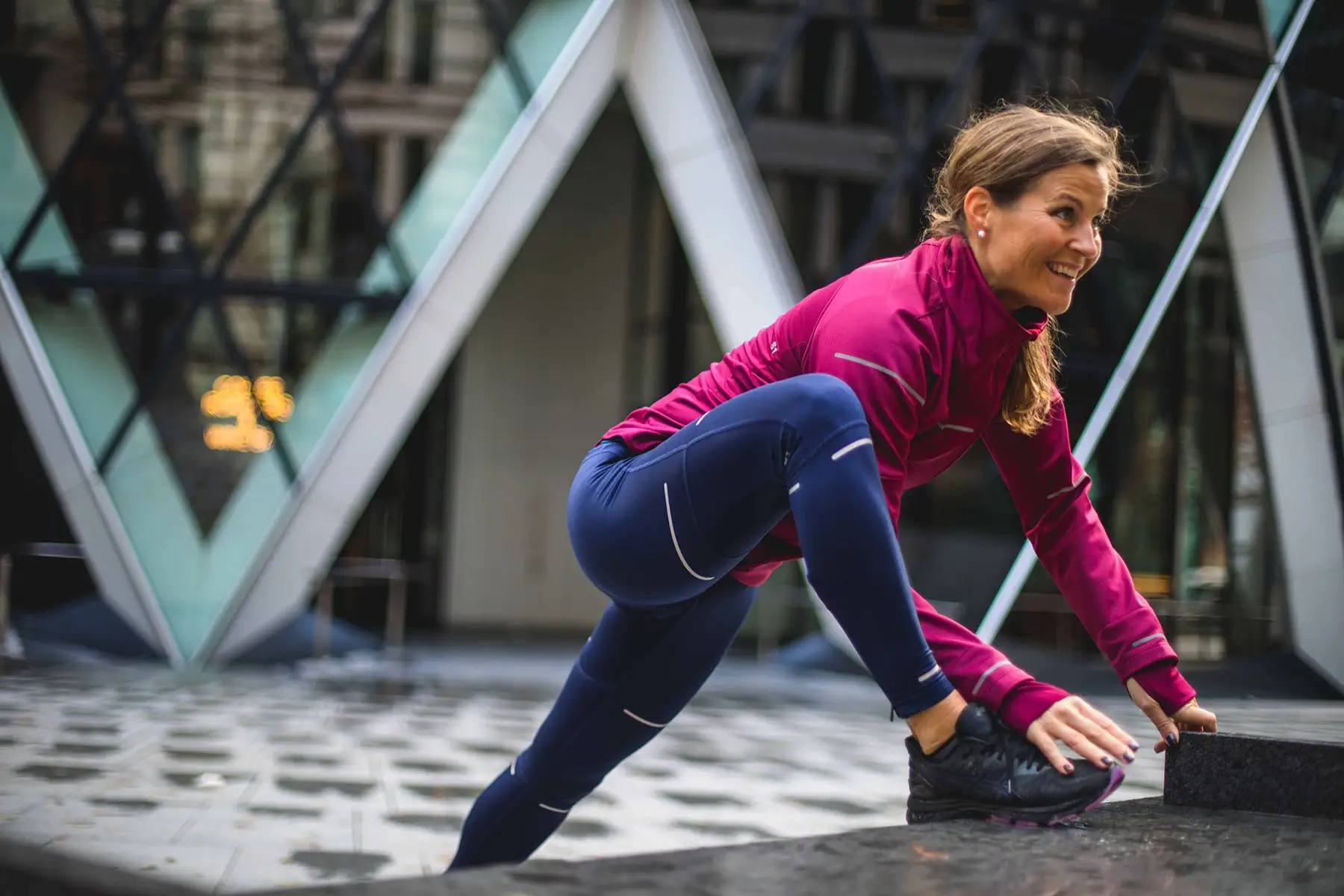
1. Standing Groin Stretch
The standing groin stretch is a flexibility exercise designed to help runners prevent and treat groin pain or strains. This stretch targets your adductor muscles, which run from your pubic bone down the inner sides of both thighs.
To begin this stretch, stand upright with arms at your hips and feet just over shoulder width apart. Turn one foot inward towards the opposite knee, so that you are creating an angle between them without bending either leg. If necessary, use a wall for balance while completing this step for comfort and correct body alignment.
2. Seated Groin Stretch
A seated groin stretch is a simple yet effective way for runners to alleviate groin pain. This type of stretch helps improve flexibility, preventing further injury and providing an increased range of motion in the area.
First, begin by sitting on the floor with your legs spread somewhat wider than shoulder width apart. As you sit up nice and tall, draw your feet together slowly, bringing them as close as possible without causing any discomfort or strain. To increase the intensity, push down gently into your inner thighs using opposing elbows.
3. Squatting Groin Stretch
The motion of this stretch focuses on stretching out the hip adductor muscles, allowing for an increased range of motion and a reduction in symptoms associated with groin pain.
To perform this stretch properly, stand upright with feet slightly wider than shoulder-width apart. With arms extended outwards, hinge from the hips and lower your torso downward until you reach a half-squat position, making sure that the knees stay over the toes while keeping the back flat.
Upon reaching full range at the bottom of your squat, hold to count five breaths before releasing up slowly to starting position. This can also be done by sitting against a wall just above knee height with one leg bent outward to strengthen the hip abductors and improve stability.
4. Isometric Ball Squeeze
Isometric ball squeeze helps build the strength and stability of the adductor muscles, which support the pelvic area. The exercise involves placing an inflatable ball or foam roller between the knees and then squeezing it for a few seconds before releasing your hold on it. This simple move will work to strengthen the muscles while helping you gain more control over them.
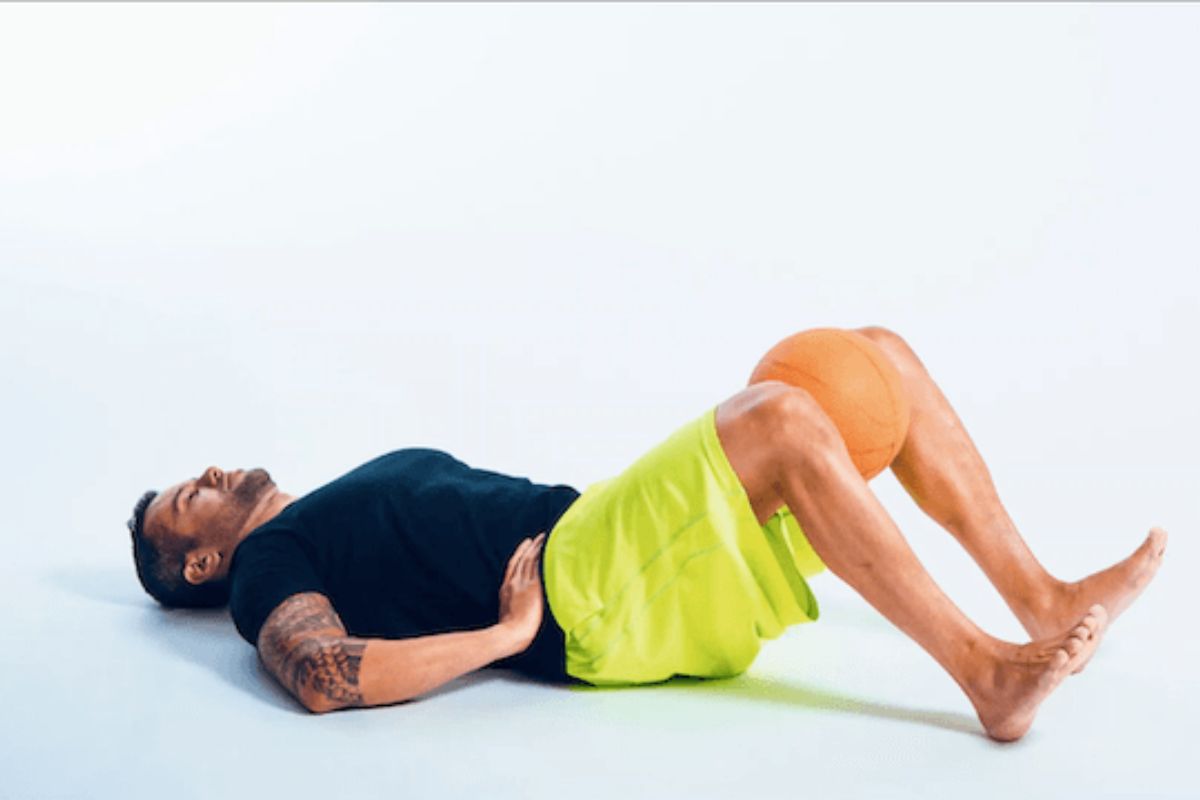
5. Adductor Drag
The adductor drag helps get rid of adductor pain after running and strengthens the muscles that are involved in running, walking, climbing stairs, and countless other activities.
This exercise consists of placing a resistance band around your ankles and then dragging your leg slowly out sideways from a wide squat position to about 45 degrees of abduction with a full range of motion while maintaining control throughout the movement.
Frequently Asked Questions About Groin Pain in Runners
Why does the inner thigh near the groin hurt after running?
Runners commonly experience pain in the inner thigh near the groin when running due to a strain or tear in the muscles that attach around this area. Inadequate warm-up and cool-down before and after runs can contribute to tight muscles and increase the risk of discomfort in this area, so a warm-up and cool-down should be included in a runner’s regular routine.
Is groin pain common for runners?
Groin pain is a common concern for runners. In most cases, the cause of groin pain after running is related to intense workouts or long-term overtraining, which can lead to strains or tears in muscles that attach around the groin.
Final Thoughts on Groin Pain in Runners
Groin pain in runners is not very common, and can be difficult to diagnose and treat. Therefore, it is important to pay attention to any signs of groin pain when running and seek immediate medical help if the pain persists or if you have other concerning symptoms.
It may take a period of rest before you are able to resume running after experiencing groin pain, and you need to gradually increase intensity.
It is best to consult an experienced physical therapist or medical practitioner for advice on strengthening exercises that will help prevent any further issues with groin-related injuries.
Have you ever tried pulled groin muscle running? Please tell us about your experience in the comments below.
Also read:
- Best Cold Weather Running Gloves
- 30 Minute Run Workout
- Benefits of Hill Sprints
- How Cold Is Too Cold to Run
- What to Wear Running in 40 Degree Weather
- Running At Night
- Best Ankle Brace for Running
- Best Running Shoes For Achilles
- Best Weighted Vests for Running
References:
- Groin Pull // WebMD: https://www.webmd.com/fitness-exercise/groin-pull
- Assessment of Athletes with Groin Pain // Physiopedia: https://www.physio-pedia.com/Assessment_of_Athletes_with_Groin_Pain
- Groin Injuries in Athletes // AAFP: https://www.aafp.org/pubs/afp/issues/2001/1015/p1405.html
- Groin Strain: Care Instruction // MyHealth Alberta: https://myhealth.alberta.ca/Health/aftercareinformation/pages/conditions.aspx?hwid=abr4623
- Groin Injuries (Athletic Pubalgia) and Return to Play // PMC: https://www.ncbi.nlm.nih.gov/pmc/articles/PMC4922526/
- Stretching for Recovery from Groin Pain or Injury in Athletes: A Critical and Systematic Review // MDPI: https://www.mdpi.com/2411-5142/6/3/73
- THE MOST COMMON GROIN INJURIES AND WHEN TO SEE A DOCTOR // Baptist Health: https://www.baptisthealth.com/blog/mens-health/the-most-common-groin-injuries-and-when-to-see-a-doctor
If you have any questions or suggestions, you can contact us via email – [email protected]






